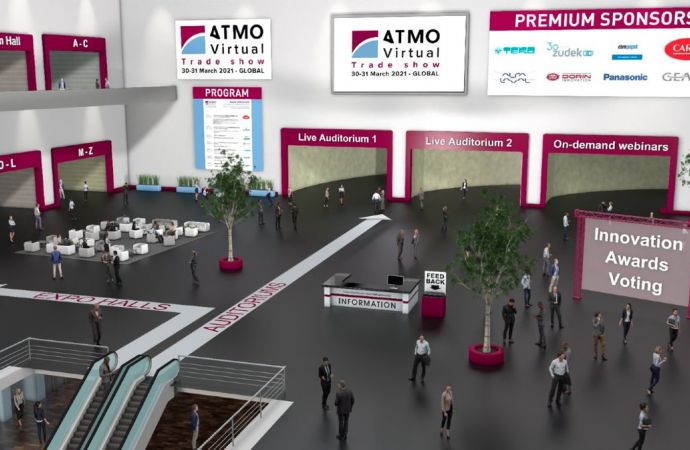Air conditioning represents the next great opportunity fornatural refrigerant adoption as global temperatures rise.

In a warming world, air conditioning (AC) use is expected to skyrocket. According to the International Energy Agency (IEA), the energy needs for space cooling will triple by 2050, with nearly 70% of the growth coming from the residential sector.
This means that energy-efficient AC systems will be a vital part of any plan aimed at curbing energy use and carbon emissions.
Natural refrigerants-based AC systems, in addition to eliminating high-GWP refrigerant emissions, have proven to be highly efficient, and figure to play a key role in the transition to more efficient AC over the next decade. Indeed, this represents the next great opportunity for natural refrigerants, following their more widespread adoption in refrigeration and heat pumps for hot water generation.
CO2 in integrated systems
CO2 (R744) is playing a growing role in the development of air conditioning, particularly at the commercial level. For example, Swiss OEM Biaggini Frigoriferi has started installing for retailer Migros Ticino (part of Swiss retail giant Migros) a large CO2 air-conditioning system, expected to be ready by March-April 2021, said Luca Rossi, a Project Manager with Biaggini Frigoriferi.
Next year, Biaggini Frigoriferi plans to add to its CO2 product range, “from small capacities up to huge capacities, and from commercial refrigeration, to industrial and HVAC,” said Rossi.
In supermarkets, a more common scenario has been the installation of fully integrated transcritical CO2 systems, which incorporate AC and heating (through heat reclaim) in the core refrigeration system.
For example, in 2018, Migros Ticino, which operates 33 grocery stores among other businesses, began using its first fully integrated CO2 system, also provided by Biaggini Frigoriferi, at a store in Riazzino, Switzerland. The store is Migros Ticino’s 21st to employ a transcritical CO2 system.
Pleased with the success of its initial integrated system, Migros Ticino plans to install it in projects planned for 2021, said Rossi, who added that the system has become the retailer's "new standard."
A number of other European OEMs also offer integrated transcritical CO2 systems. For example, Italian OEM Epta has supplied integrated systems for many years on demand. “CO2 offers a lot of exhaust heat that can be used for space heating, so it is an opportunity that can in some cases improve the total cost of ownership of the system, said Francesco Matrapasqua, Epta’s Advocacy & Regulatory Affairs Manager.
German OEM Teko has also provided integrated systems, for nearly 10 years. “What we see is that the reliability of such systems needs to be improved, especially on the component side,” noted Andreas Meier, Managing Director. In addition, the local staff has to be trained to understand that “it is not only a refrigeration system – it is also a heating system and an air-conditioning system.”
Also in Europe, the MultiPACK project, an EU-sponsored initiative, is supporting the development of integrated transcritical CO2 systems. Launched in 2016, the project is expected to wrap up in September 2021.
Another HVAC application where CO2 has started making progress is motor vehicle air conditioning (MAC). In 2017, as an alternative to the widely used R1234yf, Daimler’s Mercedez-Benz S-Class Coupé (S 400 Coupé) became the first series-production car worldwide to offer CO2 air conditioning. This was followed by other models in the S and E class.
However, because CO2 “has not yet established itself with conventional drives in the volume segment across all manufacturers, we decided to omit this option in the face-lifted current E-Class and the new S-Class model,” said René Olma, Global Communications, Mercedes-Benz Cars, Stuttgart, Germany. “We will closely monitor further developments on the market.”
Nonetheless, CO2 MAC has another route to more widespread implementation – as a heat pump providing both heat and AC in the fast-growing electric vehicles market. When used as a heat pump in a car, CO2 offers a competitive advantage in terms of energy efficiency compared to other refrigerants; it is estimated to increase driving ranges of electric cars by up to 38%, according to Sanden International, which makes CO2 compressors for mobile air-conditioning systems.
Volkswagen is one of the first car makers to include a CO2 heat pump in electric vehicles. "All m odels of the new ID [Intelligent Design] like ID.3 and ID.4 are equipped with an R744 AC and heat pump," said Christian Buhlmann, Head of Communications, Technology and Innovation, for the company. In September, Volkswagen released the ID.3 and ID.4 electric vehicles. "We are also looking at equipping other models with R744 ACs as well in the future," added Buhlmann.
This article is excerpted from Accelerate Special Issue #112 - Cooling in 2021.
Related stories




